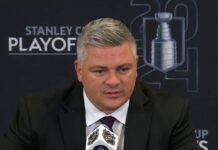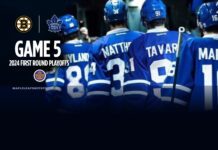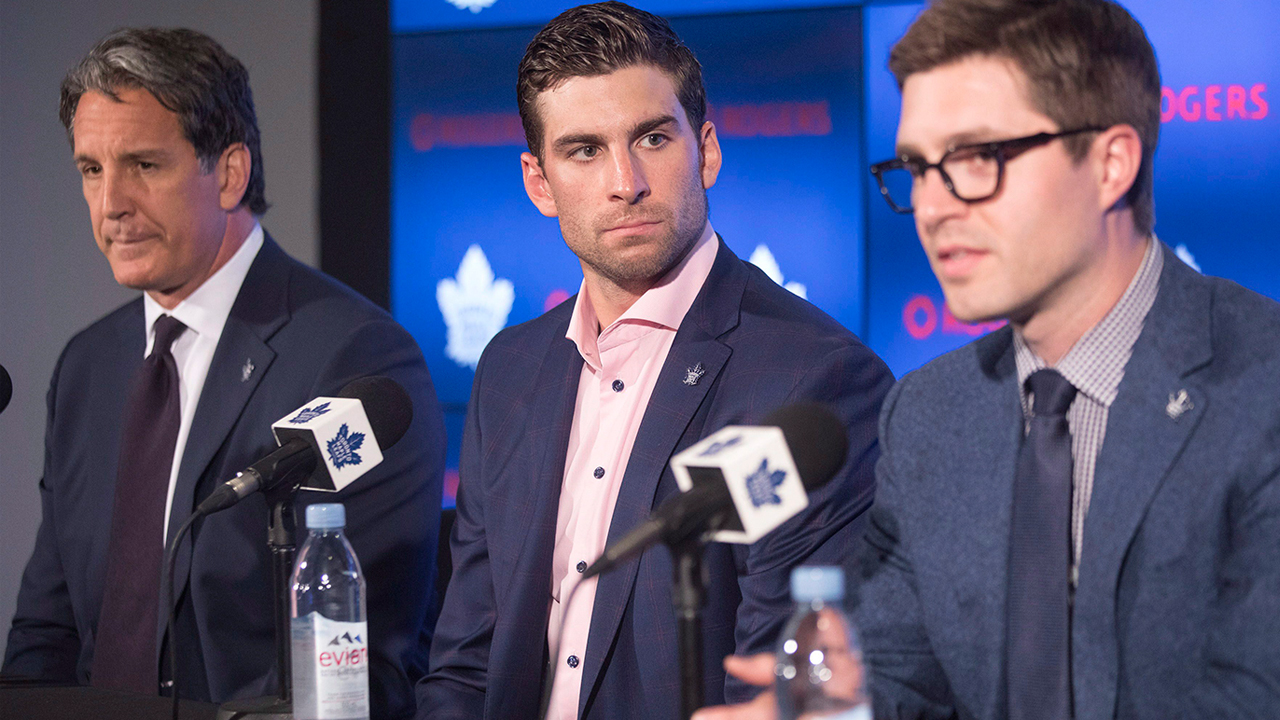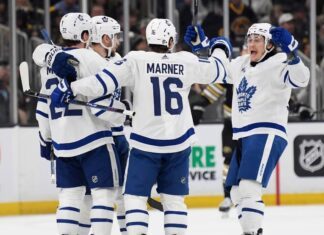Kyle Dubas joined the 31 Thoughts Podcast with Jeff Marek and Elliotte Friedman, discussing landing John Tavares, the difference between the Stamkos and Tavares pitches, the cap challenges moving forward, and much more.
At what point during the season are you starting to plan scenarios for if John Tavares becomes available on the market on July 1st?
Dubas: I think, as an organization, you are always trying to look ahead as far ahead as you can. Once we got to free agency last year, you are getting ready to plan your scouting assignments for the year ahead and the different types of projects, whether it’s your personnel department or your R&D department, to begin to look into. We also have Brandon Pridham here, who does an unbelievable job with our salary cap and our contract negotiations. You start to look ahead to what is available and what might fit and what might not fit. As we got to the trade deadline, we navigated that and started heading into the offseason, when we started to hone in on the free agents that were going to be available. Of course, a lot of them come off the board and sign extensions as time goes on. But we started to prepare just in case we had the opportunity where John got to the interview period on June 25th and began to plan how he could potentially fit into our organization. We would be able to present to him in terms of his fit with our program and roll from there.
It is a long process with these players. A lot of the work you are doing could be for not because a lot of these players do tend to re-sign with their existing club, but in this scenario where players do get to free agency, you are very thankful that you have the staff prepared as well as we did to be able to go in to LA and present our opportunity to John.
When you were hired, you did an interview with Ron MacLean, and he asked you what books you read. A couple of the ones you mentioned were one by Bill Walsh – “The Score Takes Care of Itself” – which is one that Alex Anthopolous really believed in. The other one you mentioned was, “Thinking Fast and Slow.” One of the things the author, Daniel Kahneman, talks about is pervasive optimistic bias. It is about how people think we have substantial control over our lives. He calls it the illusion of control. That week, as you make that pitch to Tavares and then you wait for his decision, how much does that sort of go through your mind as you sit there for five or six days while Tavares figures out which way he is going to go?
Dubas: It’s interesting. This is the second time in my life and short career where we have gone in and had to make a presentation. The other time was when I was interviewed to become the GM in Sault Ste. Marie. In both cases, I was the first. I was the first to interview with the board of directors in Sault Ste. Marie, and in this case, we were the first team to present to John last week – last Monday afternoon in LA at the CAA offices there. In both of those cases, they were the two times where I didn’t have a great feel for how the day had gone and for how the presentation had gone or how it had been received.
When you really, really prepare for something, you become immersed in trying to get through your presentation materials. Maybe you aren’t looking for cues from the other side as much as you would. In our case – myself, Brendan and Mike – we had thought we had done a good job but we really didn’t have a read for how it had gone. That was the same for me in Sault Ste. Marie.
You go through the whole scale of emotions for the rest of the week. You hear people say they thought you did a really good job, and then other people say, “Oh, I think they’re worried about X, Y, & Z.” You just have to ride the wave of being up and down. “I feel good about this,” or, “I don’t feel so confident about the way we presented this fact or opportunity.” You try to be optimistic the whole time, but you also look at reads presented by John and his camp through the whole thing. I didn’t really have a good read on it until late Wednesday night and early Thursday that they had thought our presentation was very well received.
Let’s jump ahead a bit. One thing that people always say is, “Nothing is done until it is done.” When was it done?
Saturday night we started to get word that he was leaning in our direction.
Dubas: It was actually done when John walked through the door of our offices, July 1st mid-afternoon. John and his fiancé walked through the door of our offices and I knew it was done.
Saturday night we started to get word that he was leaning in our direction. After the clock passed midnight, that was a sign for us that there wasn’t going to be an eight-year deal on the table. At that point, Pat Brisson and Jim Nice had started to have discussions with us about a structure. It was a conversation with John early Sunday morning where he said he wanted to be a Maple Leaf. At that point, I allowed myself to think it could be so, but it wasn’t really until…
I had been in cases like this where you are going to make a life-changing decision, and it wasn’t until the next morning when I spoke to John again – so Sunday morning, mid-morning — where I knew he had slept on it and allowed the chance for any changing of the mind. He was going to begin his correspondence to inform the fans of New York and the fan base that he wasn’t going to return. At that point, I knew it was well down the tracks. When he walked through the door and it was final, we allowed ourselves to enjoy it at that point.
We saw the emotion you can convey when Sheldon Keefe handed you the Calder Cup on the ice at Ricoh Coliseum. What was the feeling and what went through your mind when you heard the answer was yes and everything was signed?
Dubas: My emotional outbursts – they’re not all too common, but when things do get exciting, and I think when your organization accomplishes something… I tend to get more emotional when there are a lot of people involved and those people have helped to contribute to something that is very successful.
When I walked into the office on Sunday, as it was starting to build and come to its conclusion, to see some of the people in the organization that had been with the organization for a long time – and certainly those people that had been here for the four years I had been here – to see how much it meant to them, and how important of a day it was…. You’re not immune to the fact of, when it comes to signing players, in Toronto, there is a strong contingent of people who – and I would say they have been justified by past decisions – say that big time free agents don’t want to sign here. “It is too much of a fishbowl,” or whatever they may say. A lot of people in our organization don’t believe that for various different reasons. They have been trying to hammer that home for a decade or more, or in our case, for years. To see a player finally agree and take that step with us at this stage in our development as a program was massive to them and it meant a lot to them. You could see how excited people in the building were.
A very different reaction because, it’s great to have John signed, but I think John would tell you as well that it’s a good step overall and we continue to work toward our goal of contending year in and year out and putting ourselves in a position to win. The Marlies thing was different because it was a nine-month process and for some of the people there, they have been together with me for seven seasons. For better or worse, that was the last chance we were going to have as a group to finally win a championship. It was very exciting. They were both emotional events for everyone involved with varying degrees of outward emotion on my end.
This isn’t the first time that the Maple Leafs, in recent history, have gone through something like this – this type of presentation. Steven Stamkos, a couple of seasons ago, ended up staying with Tampa. What was different in the pitch to John Tavares vis-a-vis the pitch to Steven Stamkos? Were there lessons learned in the pitch to Stamkos that the organization brought to the pitch to John Tavares?
Dubas: I think, from my end, my role in both was very different. The Stamkos presentation – I was just on the periphery in the role of Assistant General Manager. I just observed and watched a lot of it. The Stamkos presentation was in Toronto and the Tavares presentation was in LA. That’s not his home turf, but it’s a building more familiar to him because it was at the agency’s offices with Pat and Jim. It was different that way. But the focus for us was only on hockey. That was the major thing that we wanted our focus to be: “Here is who we are as a hockey team and here is who we are as a program to help you reach your potential. Here is what we do on the development side. Here are all of the facets of our program that we have built over time.”
“We focused on hockey. To me, it has to always be about hockey. The periphery stuff that comes with playing in whatever market it is — that is up to the player and representative as far as what he does and doesn’t want to do.”
– Kyle Dubas on the Tavares pitch
If you rewind it two years ago, we were going in and saying, “Here is what we are going to become,” and, “Here is what we intend to be.” It was selling somebody or trying to sell them on what we intend to be as an organization that had just finished last place and took first overall, versus now in 2018, “Here is who we are, here is what we are about, here are who the players are.” It was much easier. It wasn’t selling so much as educating on where the Toronto Maple Leafs have come from 2016 to 2018.
That was the major difference: We focused on hockey. To me, it has to always be about hockey. The periphery stuff that comes with playing in whatever market it is — that is up to the player and representative as far as what he does and doesn’t want to do. There is obviously a lot of opportunity for that in Toronto because of the popularity of the sport and the team. For us, it has to be about hockey and how we are going to take care of him as a hockey player and his family, and continue to work towards reaching his goals as an individual and how that contributes to our team’s success.
One of the things we had heard was that Stamkos, when he went through this process two years ago, you as an organization felt the sponsorship stuff was a mistake, in retrospect, and that wasn’t going to be anywhere near here. True or false?
Dubas: I don’t know if we ever thought it was a mistake. I think that was something that was deemed as important to present from both sides in terms of, “These are the different types of people that can be involved.” From that element – from the business side of it — I think every player in hockey knows.
If I can go back to my agent days, whenever we would do an endorsement contract, with a player, it would be right in the boilerplate of whether it was an equipment company or trading cards or various different people who wanted to be involved on the endorsement side… it was always scaled to the market. There were teams that were in tier 1, tier 2 and tier 3, based on the following and the popularity of the sport in those markets and thus the athlete’s ability push through that market and be somebody companies may want endorsing their products.
With Toronto, and there are lots of teams like this now in hockey – whether it’s Toronto, Montreal, New York, Boston, and I would even stretch that now to Tampa and how popular the sport is in Tampa, and LA, etcetera – that stuff comes to the forefront of people’s minds when they are discussing those markets in particular. That was deemed to be something that was important in our presentation back then.
I don’t think that we thought it was wrong so much as I think that we are a hockey program. In the end, these guys want to have success on the ice and they want to reach their potential as individuals. They want to know that, if they reach their potential as an individual, it is going to contribute to great team success and the team is going to contend, and they want to know those plans more than anything else. I think that the more that we can keep the focus just on hockey and let their agents and representation worry about the other stuff, we can deflect and protect them in those ways and we are going to be far more successful that way than trying to go in and say, “Hey, if you come to Toronto…” It’s very obvious that – and I think there are a number of other teams that could say this – there is a lot of people that would want to be associated with your brand. For me, I think our focus just has to be on our hockey program at what we are doing there.
This year at the draft, first round, you select Rasmus Sandin of the Soo Greyhounds. One of the interesting stories around him this year is that part of the recruiting to get him to the Hounds was done by Barrett Hayton, who had played with him at various U17 and international tournaments. It ended up working. From the Leafs point of view, we saw players like Auston Matthews, Nazem Kadri, Mitch Marner all very publicly congratulate John Tavares on making his decision. Strong speculation is they were a part of the recruiting process. How much of that would come from the GM’s office? Would you have recruited the Kadris, the Matthews and the Marners to help recruit John Tavares?
“No matter what we go in there and do – Brendan, Mike and myself — a hockey player is coming to a program because of the people he is going to play with and the teammates he is going to be in it with every day. No matter what is written or what is said about this entire process, John Tavares doesn’t come to Toronto without the players that are here.”
– Kyle Dubas on how the Leafs landed Tavares
Dubas: I think the interesting part for me is that all of those players wanted to get involved. Once it started to get out there that Toronto is one of those teams that was a part of the process and have been given a ticket to the dance, we had our players reach out to me – a lot of them – to say, “Hey, how can we help? Do you want us to come to LA to be there? I know John. Do you want us to talk to him?”
No matter what we go in there and do – Brendan, Mike and myself — a hockey player is coming to a program because of the people he is going to play with and the teammates he is going to be in it with every day. No matter what is written or what is said about this entire process, John Tavares doesn’t come to Toronto without the players that are here. All of the credit for him coming, I think, has to go to our players because of how they have developed and how they have turned the program around over the past three seasons and what they have done. To me, it’s never about management or anything like that. It is about the players. Without those players, he doesn’t come. I think all of the credit has to go to them. They obviously had interactions with John in the last week where they shared their experience here, which I think is great.
Your players are always your best reference when a player is looking to come somewhere, and it will always be that way. Our job is to build a program out, but the players are the ones who come in and execute it. When it comes to recruiting, or when it comes to a player deciding to sign somewhere, it is always going to be the players that get that done. It’s all a credit to those guys. I’m looking forward to seeing them all together come the Fall.
What was in the video?
Dubas: That is a popular question. I think we just wanted to show John what it would be like if he was a Toronto Maple Leaf. That is what we did. It was nothing spectacular or special, I don’t think. It’s just about the people he is going to be here with, what our program is about, giving him a chance to visualize what it would be like to be a Toronto Maple Leaf and where the program is going, and go from there. I will leave the sharing [out]. I think it was a very personal thing to John. If there ever comes a day where he wants to share what it was all about, I will leave that to him. It was a very personal presentation to him.
In the Cubs Way, the book about Theo Epstein and the Cubs winning the 2016 World Series and ending the curse, they want to sign Jon Lester as a free agent, and they do it. They set it up with an official graphics company and it’s excellent work. They basically show him what it would be like to win the World series as a Chicago Cub on Wrigley Field. My question to you is – did you create a situation where Tavares or somebody with him scores a Stanley Cup goal in Toronto?
Dubas: The answer is no, and it’s not that I am a really superstitious person, but I just have a strong leniency towards not tempting karma and doing things the right way. Our messaging is we hope to get their one way and everyone can experience that for themselves, but that wasn’t something we were willing to go to in that regard. I did read that and it’s certainly very, very interesting. Whether it’s Golden State with Kevin Durant and the virtual reality goggles, and so on and so forth, there is a lot that can be done these days. We tried to build a good presentation but really tried to err on the side of caution when it comes to tempting karma with that type of stuff.
William Nylander is a big deal coming up this summer. You are still free and clear to sign Mitch Marner and Auston Matthews to extensions right now if you wanted. How do you decide which goes first? There is no book for this, but how do you decide?
“Whatever type of deal these players sign, the ultimate goal — and I know it doesn’t always work this way in hockey or in any form of athletics – is that they are going to be here for their whole careers.”
– Kyle Dubas on signing The Big Three
Dubas: I think the easy answer is there is only one of them that doesn’t have a contract for next season and that is William. These are all very important players to the Maple Leafs and the future. My belief is, rather than rushing on the first day, if a player is going to be signing up here long term – and this might be counterintuitive, and some people might not like this – I believe that you need to sit with them and convey to them what the vision for the team is and what they are signing up for for the next whatever amount of years it is. Whatever type of deal these players sign, the ultimate goal — and I know it doesn’t always work this way in hockey or in any form of athletics – is that they are going to be here for their whole careers.
When a player is going to make a commitment of any length, particularly when they are signing up long term, we need to sit with the player and make sure the player knows where we are going as a program and what our vision and our plans are. Those are discussions I will have with each of the players that are due extensions or due contracts for next season. It might go a bit slower than some people would like, but that would be on me to continue to be patient with it and make sure that these guys aren’t signing just because it’s a long-term contract – and it’s obviously a nice pay increase for them – but they want to be here as part of the long-term and know where we are going and are a full part of that, rather than sign a deal and then a year later wonder what the vision is for the program and whether they want to be a part of it. That is sort of the tactic we will take, whatever order they get done in.
I think each of them has a different representative. Those representatives have different histories and different habits when it comes to doing these types of deals and we obviously take that into account in trying to open discussions with them. But we will be very patient. I wouldn’t expect anything imminent, or at least I don’t think that as I speak with you guys, on any of the three. But we will just start to work towards them and all three of them will be a big part of it as we move ahead.
Can you keep all four of them – Tavares, Nylander, Matthews, and Marner? Does the salary structure allow you to do that?
Dubas: We can and we will.
Tyler Bozak wrote a phenomenal piece for The Players Tribune where one of the last sentences he writes is, “You are in good hands Toronto. The next few years are going to be a lot of fun. Believe in Kyle Dubas and the talent you have. Auston, William and Mitch can do anything. Trust me, I saw them in practice every day. They’re special.” What does that validation mean to you from a player who is leaving?
Dubas: I think it’s always interesting, and this might sound strange… I always thought you got your best read on how you were as a manager and what type of program you have, and the external look and opinion of the players you have within that, from people who leave. I think it’s easy for players who have left and haven’t had a great experience to be negative. In particular, if you have people who leave your program or leave your business – I don’t think it’s just to do with a sport, it’s to do with any business –the people who leave the business often don’t feel the need to be dishonest when they have a forum where they can publicly discuss what it was like.
When you have Tyler say those things yesterday, I think that’s very meaningful personally to me, but I think more importantly, to our program and about those players each day. That is not something that Tyler Bozak had to do. In most of these cases, the outgoing player will write about the city and the fans and his experience in the city. For Tyler to take that step and write that about our organization, our program and the players, I think that was very, very meaningful to me and to us. Certainly, I think we have to continue to build on that type of narrative from players who have come and gone.
If you are trying to recruit a player or someone who is going to come work for you, they are going to ask the players who are not with you but are elsewhere, “What is this person like as a manager? What is this person like as a coach? What are your teammates like?” Those people have no reason to hold back. If those people who are gone are very positive about where the program is at, I think that speaks very highly about your organization. It’s something that I think we’ve done well at and need to continue to improve upon.
“For Tyler to take that step and write that about our organization, our program and the players, I think that was very, very meaningful to me and to us. Certainly, I think we have to continue to build on that type of narrative from players who have come and gone.”
– Kyle Dubas on Tyler Bozak’s Players Tribune article
The last thing I’ll say about Tyler Bozak, James van Riemsdyk, and Leo and Roman Polak is that although they’ve signed elsewhere, this project of building the program back up is not nearly as far as long if not for the contributions of those players. Usually, in rebuilds, you see all of the veteran guys get thrown overboard at various times, and those guys were such a huge part. They were all here – Roman came and went once – from the beginning of my four years now of being with the Leafs. Their contributions of turning the program around from being a lottery team to being in the playoffs, and last year setting franchise records in various different aspects, were absolutely massive. If not for those guys, I don’t think our young players come along as well. Those are contributions I will personally never forget, having seen them first hand.
When the seconds click off and the Marlies win the Calder Cup, who were you happiest for? Sheldon Keefe would probably be at the top of that list, considering how much you personally stuck your neck out for him both in Sault Ste. Marie and in Toronto. Secondly, again with the Marlies, how much loyalty is there for the GM for positions on the Leafs next year? Those guys you were successful with at the AHL level – how much of an extra look or benefit of the doubt will they be given at training camp next season?
Dubas: To answer the first question – I was really, really happy for everybody. You start in early September and you go to June 14th, that is a long grind of a season, particularly in the American league, where you are on the bus and when you are flying, it’s not anything fancy or anything like that. There are lots of three-in-threes and there are lots of late games and five-hour bus rides back before playing in the afternoon. The contributions of everybody with the Marlies program and our player development program, day in and day out, for nine months… their commitment, their energy level, their disposition never, ever wavered throughout the whole journey.
I was very, very happy for our staff. Thrilled for Sheldon. Thrilled for our veteran players on the team, who were outstanding this year. We had an interesting mix; we had five really top-end veterans and then nothing really in between. Every game we played, we had the most entry-level players of any team throughout the year in our lineup and particularly in the playoffs. The veterans did an excellent job of bringing those younger players along.
On that note, to your second question about my loyalty to those players: I think any time you go through that and you win with people, you are thrilled. I don’t think it even requires my loyalty to them. During the stretch from May to June, where every single game of the Marlies was on TV and all of our entire Leafs staff was there and able to watch, those players earned the respect and adulation from all of our staff. I think they earned the ability to put themselves into that mix for next year without me having to do a single thing – as it usually is.
In sports, the players are the ones who go out and accomplish it. I was really, really happy that a lot of these players — whether it was Andreas Johnsson, Trevor Moore, Justin Holl, Martin Marincin, I can go on down the list for a long time – played so well every night throughout the playoffs. I think their performance is what has earned them an increased opportunity come the Fall. What I know about them now is that when things get tough, they are going to dig in and continue to perform and perform well. I am very excited for them. I know it’s already just over two months away from our rookie tournament starting, so we are excited about that.


































